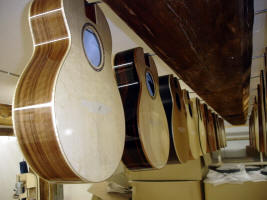|
Lukas Brunner and the World’s First Travel Harp Guitars! by Gregg Miner |
|
“The Natural Sound of Innovation” The slogan of Switzerland’s Brunner Guitars sums up founder Lukas (Luke) Brunner’s guiding force. Finding innovative yet practical solutions to the design and construction of guitars is something he considers both a privilege and a gift. During his youth, Luke apprenticed with a furniture maker after hanging out in his dad’s custom furniture shop from his earliest years. At age 14 he started playing guitar, and with his woodworking experience, his interest in guitar building began to grow. By 1992, now age 18, he built his first guitar, a dreadnaught. Brunner Guitars soon opened in 1995 when Luke started building guitars full time at the age 21. His experience as a cabinetmaker and occasional guitar builder prepared him for the challenge and enabled him to become established, but it was his invention of the Outdoor Guitar that really got the ball rolling. He now works with a small team of three additional workers and can “batch-build” high end guitars to sell for very attractive prices. |
|
|
|
 |
 |
 |
 |
 |
| In 2000, the business moved to its current location in the town of Lavin in the incredibly beautiful valley of Engadin. | |
|
> What in the world am I doing in L.A.?! |
| At the other end, a special
captive nut and a zero fret allow the strings to remain aligned,
while the
locking Gotoh tuners help keep things consistent while the neck is off.
All three features combine seamlessly with the Snap-On neck to provide
near tuning-free reassembly. Pretty cool, so far, huh? We
could probably stop there and call it a success... But how to get decent tone out of this portable “kit” guitar? Ahhh, Luke’s next bit of wizardry… |
|
The Flying Top In 2002, Luke invented his unique “Flying Top.” Thinking about how standard X-bracing divides the top into different vibrating areas, he brainstormed on a way for the top to “float” more freely and thus vibrate more evenly at all frequencies. |
||
|
|
||
 |
As I understand it,
there are two key components to Luke's design, both rather ingenious. First, the top is strengthened with a smaller, thin piece of book-matched spruce that is feathered at the edges. With the grain of the center piece at a slight angle to the top, the two pieces are glued together in an arched press for even greater strength. |
| The Birth of the
Outdoor Harp Guitar In June of 2008, French harp guitarist Philippe Fouquet (at right) wrote me about a new harp guitar he was ordering. Philippe, an excellent steel-string fingerstyle guitar player had been using an old kontragitarre strung with silk and steel. He was desperate for a Dyer-style instrument to begin fully exploring his harp guitar technique and compositions, but was finding it hard to invest in the sort of instrument he knew was needed. What he decided on was a custom instrument that he had talked Luke Brunner into building for him. Luke would need to modify his small, portable Outdoor Guitar into a doubleneck version, with the second neck able to handle six sub-basses tuned all the way down to low E! I know – I didn’t believe it either. |
| For the harp guitar version of the Outdoor Guitar, Luke added a
third layer of thin feathered wood to the top (grain aligned with
the top, angle to the middle piece). This is to support the extra
tension of the sub-bass strings. As Luke explains, this 3-layer
"top sandwich" is about 6mm thick in the area between bridge and
soundhole, feathering out to about 2mm along the outside. He
likens the theory to the principal of a Hi-Fi speaker cone. The final piece of the puzzle is the distinctive rosewood bridge plate (nice and clean - no bridge pin holes!). Primarily this was developed to stiffen up the top in the bridge area and to add more mass to the centre of the top, which provides more sustain. Again, lightness and flexibility along the edge - in tandem with the freely vibrating top - are the keys to the success, only achieved after much innovative experimentation. By the way, if I've given the impression that I am responsible in any way for this unique instrument, I didn't mean to. All credit should go to my friend Philippe Fouquet, who had the conviction and willingness to break the "hollow-arm harp guitar" paradigm, and to Luke Brunner, for so brilliantly realizing these instruments. Innovation indeed! P.S. We're almost done..... |
|
OK, OK! So how do they sound?! Frankly, they are somewhat mind-boggling. For the few who have played them so far (including none other than Stephen Bennett) the tone and projection are a complete surprise. Both Stephen and I agreed that had we not each owned a couple of fantastic harp guitars, we would not mind in the least touring, performing or recording with one of these (the string spacing at nut and bridge – less than we’re used to on our Dyers - being our one and only complaint). Philippe also loves his and is starting to concertize and record even now. But you don’t have to take our word for it - click over to the instrument listing at Harp Guitar Music for a direct A/B comparison with a vintage Dyer and see for yourself. As The Monkee's said, "I'm a Believer." |
|
| If you enjoyed this page, or found it useful for research, please consider supporting Harpguitars.net so that this information will be available for others like you and to future generations. Thanks! |
|
|
|
All Site Contents Copyright © Gregg Miner, 2004,2005,2006,2007,2008. All Rights Reserved. Copyright and Fair Use of material and use of images: See Copyright and Fair Use policy. |